Discover the fantastical world of Alagaësia and journey alongside its most intriguing dragon rider in Christopher Paolini’s best-selling series, the Inheritance Cycle. This epic saga, which started with “Eragon,” entwines you with a story of heroism, loyalty, and destiny.
As you follow the young dragon rider’s journey, you experience his struggles, triumphs, and the intricate world Paolini masterfully crafted.
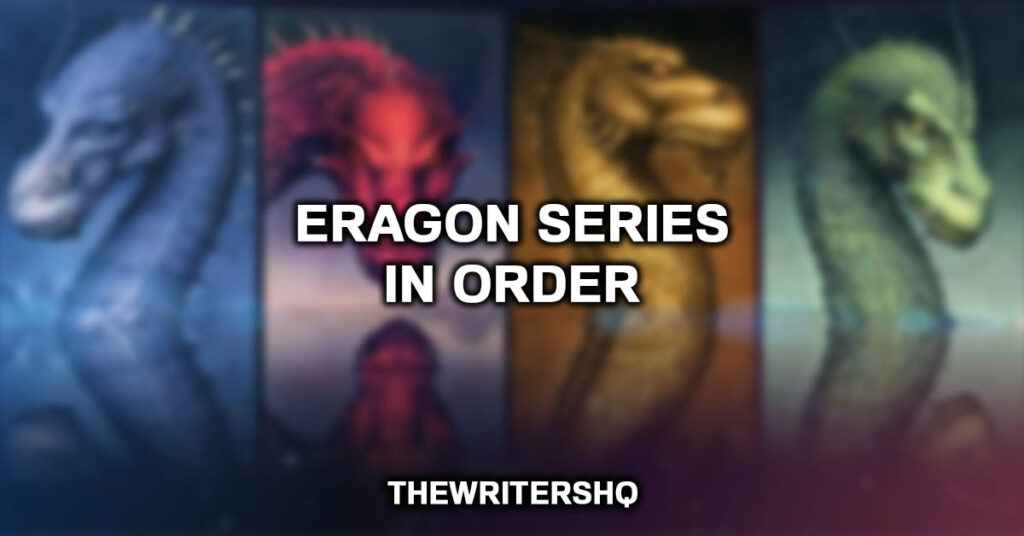
Eragon Books in Order:
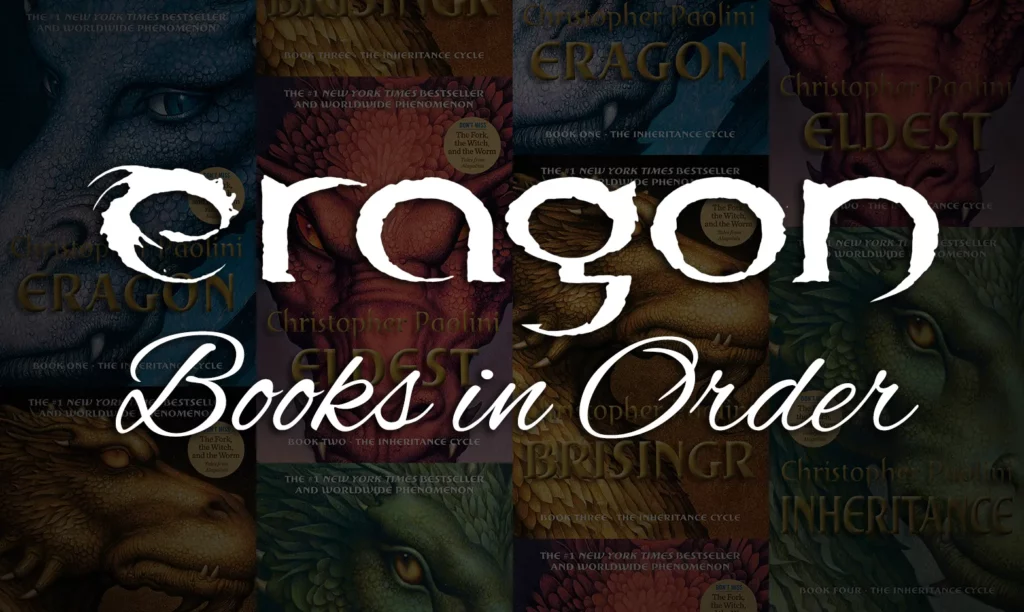
- Eragon (2002)
- Eldest (2005)
- Brisingr (2008)
- Inheritance (2011)
- The Fork, the Witch, and the Worm: Tales from Alagaësia (Volume 1: Eragon) (2018)
Here’s a summary of each book:
Eragon (2002)
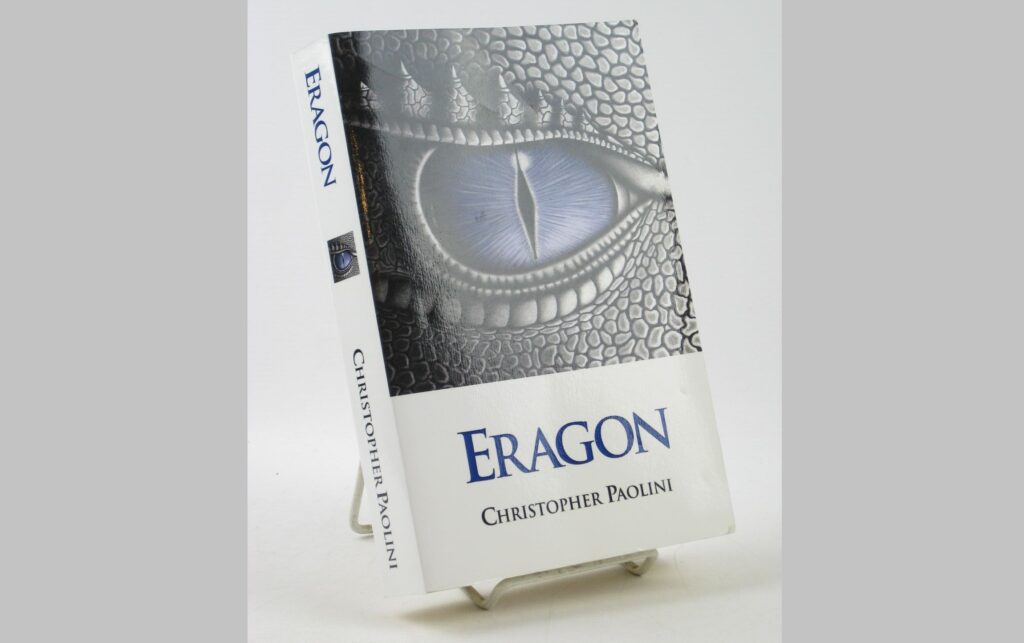
Eragon, a 15-year-old farm boy, stumbles upon what he believes to be a polished stone in the forest of his homeland, the Kingdom of Alagaësia. To his astonishment, the stone hatches a dragon named Saphira, marking the return of the legendary Dragon Riders who were all but extinct.
With the guidance of a storyteller named Brom, Eragon, and Saphira undertake a journey across Alagaësia to master their newfound abilities, evade the tyrant King Galbatorix who hunts them, and eventually help in the rebellion against the unjust rule of the Empire.
Eldest (2005)
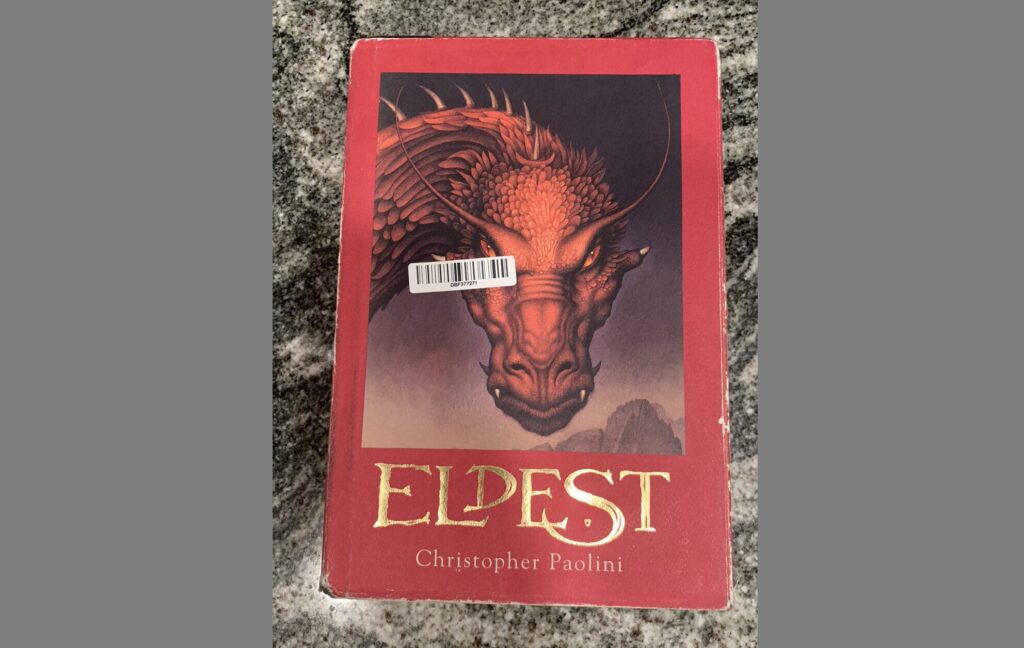
Eragon and Saphira travel to Ellesméra, the elven capital, to receive further training in magic, combat, and the ancient language. As Eragon learns more about his heritage and destiny, his cousin Roran embarks on a mission of his own to rescue his beloved Katrina who’s been kidnapped by the Ra’zac.
Quick Fact: The novel culminates with a dramatic battle at the Burning Plains, leaving readers on the edge of their seats.
Brisingr (2008)
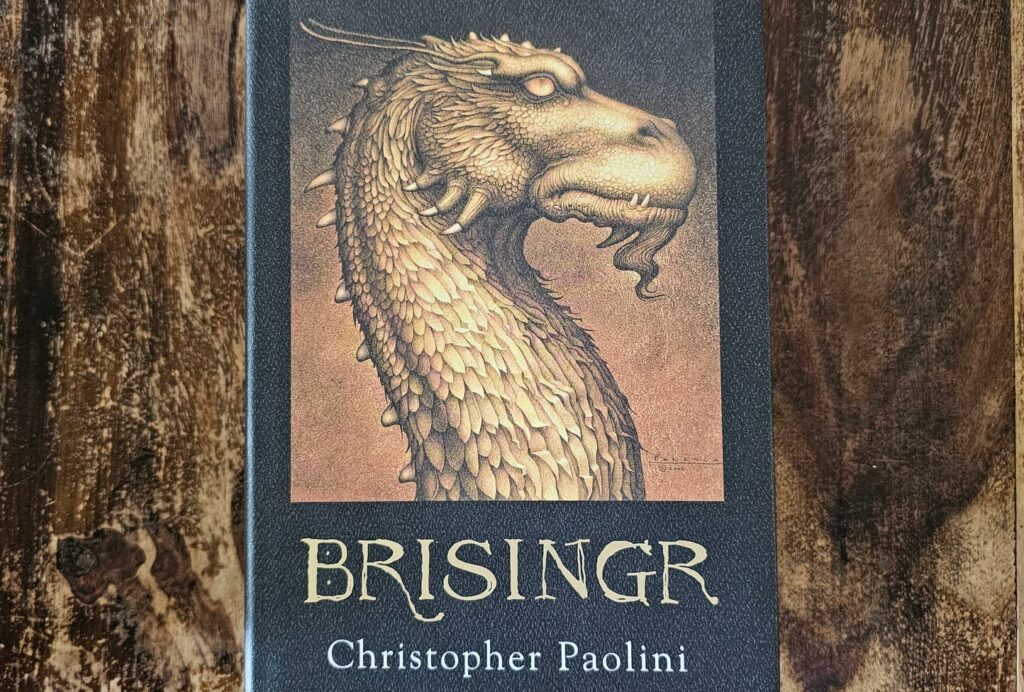
The story continues with Eragon and Saphira honoring their commitments to Roran and their dwarven allies. Eragon’s character evolves as he grapples with complex moral issues and confronts his ancestor’s legacy. This book reveals more about Galbatorix’s powers and lays the groundwork for the final confrontation.
Inheritance (2011)
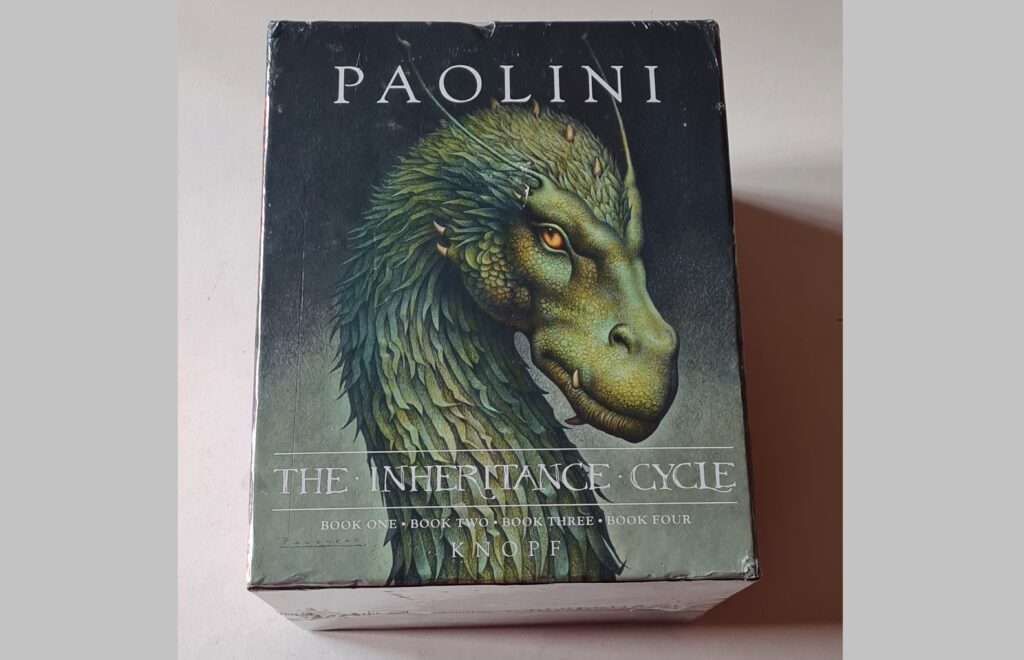
The final book in the cycle, Inheritance brings Eragon and Saphira’s journey to a thrilling climax. With the final battle against King Galbatorix looming, they must unite the rebel forces and free Alagaësia from the King’s rule. They face insurmountable challenges, culminating in a finale that decides the fate of their land.
Eragon’s profound love for his dragon, his resolve to fight against the odds, and his character development reach a peak in this concluding novel.
The Fork, the Witch, and the Worm: Tales from Alagaësia (Volume 1: Eragon) (2018)
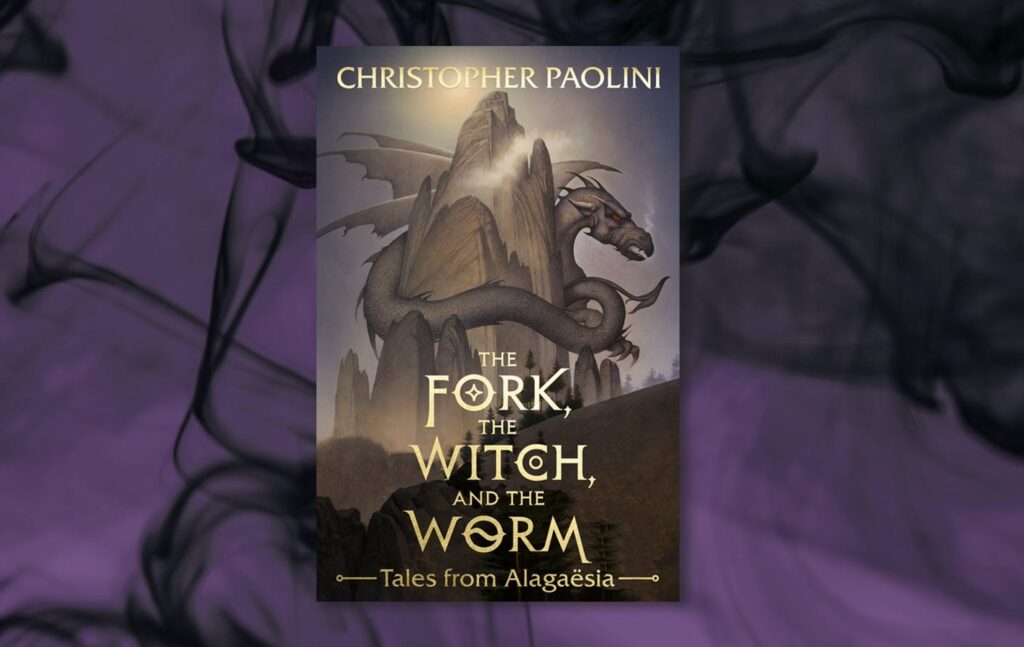
This book is a collection of three short stories set in the world of Alagaësia, following Eragon’s life after the events of the Inheritance Cycle. Each story provides further insight into the world and characters of Alagaësia, building on the lore of the series and offering a satisfying continuation for fans of the original saga.
Order of Reading The Inheritance Cycle
The best way to read the Inheritance Cycle is in the order of publication. This order allows you to follow the narrative arc and character development as the author intended:
Eragon (2002)
Eldest (2005)
Brisingr (2008)
Inheritance (2011)
After completing the main series, you may want to read the companion book: The Fork, the Witch, and the Worm: Tales from Alagaësia (Volume 1: Eragon) (2018)
Number of Books in the Eragon Series
There are four main books in the Inheritance Cycle series (Eragon, Eldest, Brisingr, and Inheritance) and one companion book (The Fork, the Witch, and the Worm).
Are the Eragon Books Finished?
As of my knowledge cutoff in September 2021, the main series of the Inheritance Cycle (Eragon, Eldest, Brisingr, Inheritance) is completed. Christopher Paolini has also written a companion book (The Fork, the Witch, and the Worm), which comprises three short stories set in Alagaësia.
However, Paolini has indicated that he has plans to continue the series with additional books, which may expand on the world and characters introduced in the original series. So, while the main series is completed, the broader universe of Eragon might not be.
Are Eragon and Arya in Love?
Throughout the series, it’s clear that Eragon has deep feelings for Arya, an elven princess. His affection for her grows from admiration to a deep, profound love as the series progresses. However, Arya, who is significantly older and initially holds a more reserved attitude, does not reciprocate these feelings in the same way.
Arya acknowledges Eragon’s feelings but frequently reminds him of the practical realities that prevent a relationship: their different life spans (elves live much longer than humans), their distinct responsibilities, and the challenges their world faces.
While there are moments of deep connection between them, it’s more accurate to say that they share a deep respect and a bond formed by shared experiences rather than a romantic relationship in the conventional sense.
Quick Fact: The series ends with them on different paths, further suggesting the unlikelihood of a traditional romantic relationship. However, their relationship is complex and layered, forming one of the series’ emotional cores.
What influences led Christopher Paolini to create the world of Alagaësia?
Christopher Paolini was homeschooled, and during his teenage years, he took inspiration from the stunning Montana landscape surrounding him, using it as the basis for the diverse environments found throughout Alagaësia. Paolini is also a big fan of fantasy and science-fiction literature.
Works like J.R.R. Tolkien’s “The Lord of the Rings” and Frank Herbert’s “Dune” influenced his storytelling, world-building, and character development. He blends these influences into the rich, detailed, and diverse world of Alagaësia, creating a unique and engaging setting for his characters.
How does Eragon’s character develop throughout the series?
Eragon’s character growth is one of the defining aspects of the Inheritance Cycle. Starting as a naive farm boy, Eragon is thrust into a life filled with magic, adventure, and responsibility when he finds Saphira’s egg. Throughout the series, he struggles with the weight of his new duties as a Dragon Rider, his love for Arya, and the ongoing conflict with Galbatorix.
He makes mistakes and learns from them, often the hard way, maturing and growing wiser. By the end of the series, Eragon evolves into a seasoned warrior and wise leader who isn’t afraid to make difficult decisions for the greater good. His character development is a testament to Paolini’s storytelling ability and one of the series’ core strengths.
What is the significance of the relationship between Eragon and Saphira?
Eragon and Saphira’s bond is the central relationship in the Inheritance Cycle. It’s not just companionship they share a profound, telepathic connection that allows them to understand each other’s thoughts and feelings deeply. Their relationship is symbiotic, with each providing support, wisdom, and strength to the other.
Saphira, in many ways, acts as Eragon’s guide, protector, and moral compass, helping him navigate the complex world they find themselves in. On the other hand, Eragon’s loyalty, bravery, and love provide Saphira with a partner she can trust and rely on. Their bond is the heart of the series, grounding the epic fantasy elements in a relatable, emotional core.
How does Christopher Paolini explore the theme of power and its effects in the series?
The theme of power is intricately woven throughout the Inheritance Cycle. It’s evident in Galbatorix’s tyranny over Alagaësia, his misuse of power driven by madness and vengeance. His rule stands as a warning of unchecked power and the corruption it brings.
However, power is also explored through the Dragon Riders. Their abilities set them apart, but with it comes immense responsibility. Eragon’s journey is a struggle with this responsibility, learning how to wield his power justly and for the benefit of others.
The series delves into the moral complexities associated with power, how it can corrupt, and how it can be harnessed for good, offering a nuanced exploration of this theme.
What role do the supporting characters play in the Inheritance Cycle?
The supporting characters in the Inheritance Cycle are fundamental to the plot and contribute significantly to world-building. Characters like Brom, the old storyteller who becomes Eragon’s mentor, Roran, Eragon’s resilient cousin, and Arya, the elven princess, each have their unique roles and character arcs.
Brom provides crucial wisdom and training to Eragon, setting the foundation for his journey as a Dragon Rider. Roran’s storyline, especially in “Eldest” and “Brisingr,” showcases his bravery and leadership, proving you don’t need magical abilities to be a hero.
Arya serves as a bridge between the humans and the elves, and her complex relationship with Eragon adds emotional depth to the series.
How does Christopher Paolini handle the concept of good versus evil in the Inheritance Cycle?
The Inheritance Cycle certainly features a clear conflict between good and evil, with Eragon and the Varden representing good and Galbatorix representing evil. However, Paolini adds depth to this by exploring the grey areas.
Eragon, despite being the hero, often grapples with difficult moral decisions and is forced to question the nature of his actions. On the other hand, Paolini provides a backstory for Galbatorix that paints him as a tragic figure who was warped by his own power and loss, adding layers to his character.
The series underscores that the concepts of good and evil aren’t always straightforward and are often influenced by perspective, power, and personal loss.
Can you explain the influence of the ancient language on the magic system in the Inheritance Cycle?
The magic in the Inheritance Cycle is intricately tied to an ancient language known as the “Language of the Elves” or “Ancient Language.” Knowledge and understanding of this language allow the caster to manipulate the world around them, but always at a cost equivalent to the task’s physical toll.
The ancient language’s words have a true meaning, directly tied to the essence of what they represent. Thus, using these words in magic ensures precise control over the spell’s effects. However, a mispronunciation or misuse of the words can have unintended and often dangerous consequences.
It’s an elegant system that ties together language, knowledge, and power. Eragon’s growth as a character is often mirrored in his increasing understanding and usage of the ancient language. The magic system is a testament to Paolini’s skill in world-building, weaving language, and magic into a cohesive and engaging whole.
How does Christopher Paolini depict the concept of destiny in the Inheritance Cycle?
Throughout the Inheritance Cycle, the concept of destiny is a recurring theme. The story begins with Eragon being chosen by Saphira, marking him as a Dragon Rider and setting him on a course to fulfill a prophecy. Yet, Paolini does not present destiny as an inevitable, uncontrollable force.
Instead, he frames it as a path that his characters can influence through their choices and actions. Eragon, in particular, demonstrates this as he constantly learns, adapts, and makes choices that shape his destiny. This approach adds depth to the narrative, empowering characters, and highlighting the importance of personal growth and choice.
How does the Inheritance Cycle portray the complexity of war and conflict?
While the Inheritance Cycle is steeped in fantasy, it does not shy away from the harsh realities of war and conflict. Paolini provides a realistic portrayal of war, emphasizing not only the physical battles but also the psychological toll it takes on those involved. Characters are faced with loss, fear, and the moral ambiguities of warfare.
There are no simple solutions, and victories often come with substantial costs. The consequences of the conflict are visible throughout Alagaësia, affecting its inhabitants and shaping the narrative in a profound way.
How does the character of Arya defy typical fantasy stereotypes?
Arya, the elven princess, is a remarkable character who stands out for defying typical fantasy stereotypes. Instead of a damsel in distress, she is a warrior, diplomat, and scholar with centuries of experience. Her independence, resilience, and complexity make her a character with her own agency.
Even her relationship with Eragon, the series’ protagonist, is unconventional. Despite Eragon’s deep feelings for her, she maintains her independence and prioritizes her responsibilities, providing a fresh take on romantic relationships in fantasy novels.
What are the unique aspects of the magical creatures in the Inheritance Cycle?
Paolini populates Alagaësia with a diverse range of magical creatures, each with unique characteristics that contribute to the series’ richness. Dragons, like Saphira, are wise, sentient beings capable of telepathic communication and forming deep bonds with their riders.
The Ra’zac are formidable creatures that evoke fear and serve as relentless adversaries for Eragon and his allies. The series also features Werecats, Urgals, and more. Each creature adds to the depth and complexity of Alagaësia, contributing to the vibrancy of the world Paolini has created.
How does the Inheritance Cycle explore themes of friendship and loyalty?
Friendship and loyalty are strong undercurrents throughout the Inheritance Cycle. Eragon and Saphira’s deep bond is a shining example, but there are also friendships between Eragon and his mentor Brom, Eragon and his cousin Roran, and various members of the Varden.
These relationships are tested throughout the series, sometimes strained, but ultimately strengthened in the face of adversity.
Quick Fact: The series shows that loyalty and friendship can be powerful forces, providing strength, solace, and inspiration in even the darkest times.
What role does the character of Galbatorix play in the Inheritance Cycle?
Galbatorix is the central antagonist of the series, his reign of terror over Alagaësia providing the main conflict that drives the narrative. However, he’s more than a simple villain. Paolini gives him a backstory of personal loss and betrayal, leading to his descent into madness and tyranny.
While his actions are undoubtedly destructive, this backstory adds layers to his character and shows how power and grief can corrupt. Galbatorix’s influence permeates every aspect of the story, even when he’s not directly present, making him a formidable and fascinating character.
What is the significance of the title of each book in the Inheritance Cycle?
Each title in the Inheritance Cycle carries significant meaning. “Eragon” is named after the protagonist, signaling the start of his journey. “Eldest” refers to Eragon’s role as the last free Dragon Rider and the oldest living dragon, but it also introduces the idea of heritage and lineage, particularly through Eragon’s training with the elves.
Brisingr” is a word in the ancient language that means “fire,” a critical element in Eragon’s development and a turning point in the series. Finally, “Inheritance” represents the culmination of Eragon’s journey as he inherits the mantle of the Dragon Riders, along with the responsibility of shaping Alagaësia’s future.
The titles, therefore, not only represent the content of each book but also symbolize key stages in Eragon’s journey.
Conclusion
The Inheritance Cycle, starting from “Eragon” and concluding with “Inheritance,” is an epic saga that takes readers on an unforgettable journey through the mythical world of Alagaësia. Christopher Paolini’s adept storytelling weaves together themes of destiny, power, war, friendship, and heritage, creating a layered narrative that resonates with readers.
The characters, from Eragon and Saphira to Arya and Galbatorix, are complex and engaging, contributing to the richness of the series. Overall, the Inheritance Cycle is a remarkable exploration of heroism, loyalty, and destiny, leaving a lasting impression on the landscape of fantasy literature.
